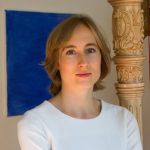—by Hannah Lash

I really love the harp. It pulls me in; I find it sort of addictive. Though I am a composer, and that has been my musical focus all my life, my instrument has always been harp. In the way that the piano is a staple for a lot of my composer friends, harp is the instrument I go to when I want to play through a chord progression, read through some Bach, or check some counterpoint.
But it’s more than a musical tool for me—it’s a major part of who I am. We spend a lot of time together. I practice four or five hours a day, partly to hone my technique as a player, and partly to deepen my sonic imagination and musicianship as a composer.
The Harp’s capabilities are limitless, as long as you understand what the physical premises are, and write music specifically designed to engage the instrument’s strengths.
It’s not particularly unusual for a composer to be a competent or even a virtuosic pianist. But for a composer also to be a harpist—and a serious performer to boot—is quite unusual. I’m not exactly sure why this is, to be honest. The harp is just as useful a polyphonic tool as the piano, and I’ve never found the pedals and getting a chromatic palette to be as problematic as I think people who don’t know the harp well would imagine. Perhaps it’s because the harp is incredibly technical—it’s a hard instrument to play. If you don’t practice daily, not only do you lose technique, but you lose calluses to blisters next time you sit down to play. So I suppose that given the technical and physical maintenance the harp requires, the piano provides the path of least resistance for composers.
Or maybe, for the budding composer, the piano’s rich repertoire makes it more attractive than the harp. While it has some gems, like Hindemith’s Sonata, C.P.E. Bach’s Sonata, Fauré’s masterpiece Une chatelaine en sa tour, or Rota’s Sarabanda e toccata, the harp cannot boast the same volume and quality of repertoire as the piano. This question of repertoire has always been on my mind. When I was younger, it caused me to drift a bit from the harp. Unable to stay away from it for long, I returned to my first love, determined to transcribe each and every piece of piano music I adore for the harp. The result? The harp + Scriabin piano sonatas = frustration + tendinitis.
After all the harp has done for me, I feel like I can and should be useful to the harp. Although I have a lot of compositional projects, many of them having nothing to do with harp, I feel very strongly about expanding the repertoire for my instrument and making as significant a contribution as I possibly can.
I actually find the harp’s historical position to be an opportunity. The instrument has not been totally defined yet (not that any instrument has ever been totally defined, but some have been more thoroughly explored than others). I find the harp to be an unbelievably expressive voice with far more flexibility than many composers attribute to it. I believe it has capabilities that are yet to be unlocked.
Recently a friend asked me what I thought a harp does better than a piano. I was tempted to be glib and respond by saying that a harp does harp better than a piano, just as a piano does piano better than a harp. But actually, it was an interesting question in how it illuminated the way people perceive the harp as a kind of version of the piano. It also hit home for me after my own struggles to transcribe the most pianistic of piano music.
So I thought about the question and tried to answer in as concretely as I could. I ended up saying something about the harp’s range of dynamics, the delicacy and speed of fast figuration that is possible, and the sense of control over the color of sound afforded by the direct contact of the fingers on the strings. There is some truth to these points, but ultimately the comparisons between the two instruments are futile outside of the context of music. The harp is a harp. It is not a version of the piano. They are related, but very different. The harp’s capabilities are limitless, as long as you understand what the physical premises are, and write music specifically designed to engage the instrument’s strengths.
I care passionately about giving the harp the very best music I can create. I hope I can illuminate its strengths and expand its palette, as it constantly illuminates my voice as a composer and expands my palette as a musician and player. In writing music for harp and performing my music, as well as standard repertoire and current music by other composers, I hope to do my part in helping the harp achieve a more mainstream status in the minds of audiences and presenters. I also hope my harp compositions encourage other composers to write harp music. Most of all, I hope more young composers will begin to choose the harp as their instrument, continuing to shape it into the future of music. •





